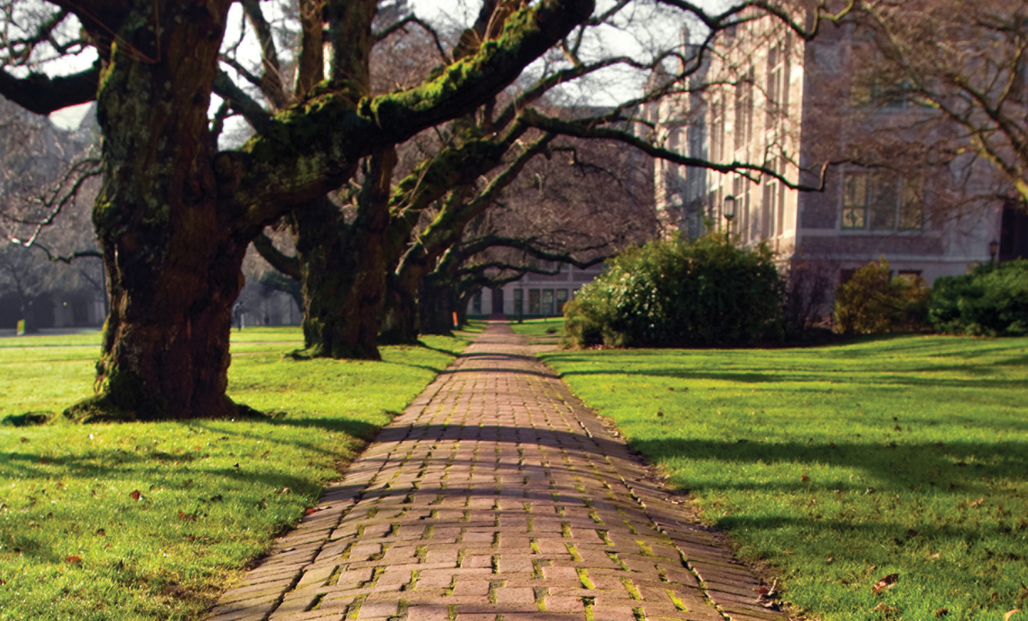The Center for Urban Waters in Tacoma, Wash., is a research center and community of environmental scientists, analysts, engineers and policymakers who develop creative and sustainable solutions to restore and protect urban waterways. The unique intellectual environment brings together organizations with complementary missions and individuals with diverse skills to develop innovative approaches to environmental restoration, as well as protected and sustainable urban development.
Research is led by the University of Washington Tacoma in a LEED® Platinum facility on the east side of Tacoma's Thea Foss Waterway. City staff assigned to the center work on critical environmental services for the citizens of the community. The collaboration includes the Puget Sound Partnership, a state agency coordinating efforts to restore and protect Puget Sound.
As part of its institutional mandate, the Center for Urban Waters provides a number of educational opportunities, such as informational tours and signage throughout the facility, to provide educational communications to the public about the building's sustainable solutions and the facility's two vegetative roof systems. Energy and water consumption is constantly monitored and visually displayed in real time in the center's lobby.
Although a vegetative roof system can be beneficial, an improperly designed one can be costly and challenging to upkeep. After the Center for Urban Water's property management company had difficulty maintaining the facility's vegetative roof systems, it called upon the experts at Nations Roof, Seattle, for help.
An unwiedly roof
Because it is located on a shoreline, managing the Center for Urban Waters' stormwater is a priority for the organization. Stormwater that is not removed through evapotranspiration (the sum of evaporation and plant transpiration) on the roof is drained, collected and stored in two 41,000-gallon cisterns for reuse throughout the facility, including the building's toilets.
The facility's vegetative roof systems, pervious pavement, rain gardens and other plantings make the site almost entirely porous. Efficient irrigation is distributed via drip lines and controlled by an evapotranspiration-adjusted irrigation controller.
The vegetative roof systems help to effectively manage the building's stormwater, but managing and maintaining these roof systems can be another matter. Kidder Mathews, Tacoma, Wash., the center's property management company, struggled with the upkeep of the vegetative roof systems on the LEED building for quite some time, and maintenance became costly.
When Melinda Martinez, CPM, RPA, senior property manager for Kidder Mathews, met Jennifer Stone, LEED AP, GRP, president of Nations Roof Northwest office, she had many questions about vegetative roofs.
"Melinda and I hit it off right away," Stone says. "When she learned about my background in horticulture, specifically 'green' roofs, she started drilling me. She had been struggling with one of her buildings and maintaining the two vegetative roof systems they managed."
After a few conversations, Stone suggested they meet on-site so Stone could get her hands in the soil and survey the situation. After the first site visit, Stone developed a comprehensive maintenance plan for both roof systems, but the plan was tedious and costly.
"It did not take long to see the maintenance to keep the vegetative roof systems to the expectations of the client and original roof planting was an extremely costly venture," Stone says. "So our team quickly got to work on bringing together experts to look at the full life cycle of the roofs."
Growing forward
The bottom line for any city building is operating cost, but the Center for Urban Waters' vision also is to be a sustainable site. The roof systems are an integral part of that vision, and with the facility's water filtering and reuse process, using herbicide is not part of a vegetative roof system's maintenance plan.
The original planting design left many gaps for weeds and a thick moss cap to grow, making hand-weeding quite time consuming. The roof also had several nonvegetation zones that were difficult to maintain.
"Plants and weeds apparently do not like to stay in one place," Stone says. "They like to grow!"
Working with plant expert Darcy Drysdale from Etera, a local grower, Nations Roof presented a plan to the city of Tacoma and Kidder Mathews that included an aggressive approach to replant the roofs.
"With our cost analysis, we balanced maintenance needs with the cost to replant the roofs and the return on investment only was three years," Stone says. "Plus, the savings on the maintenance budget moving forward made the plan a wise and truly sustainable decision for the project."
After receiving approval of their plan, in February 2014, Nations Roof started with the building's lower 2,000-square-foot roof as a test run. After successfully completing the lower roof, in July 2014, Nations Roof was contracted to remediate the upper 9,000-square-foot vegetative roof system.
Safety challenges
Nations Roof relied on its safety coordinator, Kendra Cabrera, to review the project and complete a site-specific safety plan and job hazard analysis.
"Kendra started with our office as a laborer out in the field," Stone says. "She quickly rose to the top as a result of her 'can do' attitude that nothing is off limits to try. The more I saw Kendra in action, the more I realized what an asset she is to our company.
"She was a Girl Scout leader for 13 years, is CPR-certified and forklift-trained, has done all her own electrical and plumbing in her own home, and she has a community FEMA CERT (community emergency response team certificate). We are proud to have Kendra on our team and have her be part of Nations Roof as our safety coordinator."
Under Cabrera's direction, a safety plan was implemented. Although the parapet walls were high enough in most places, perimeter warning lines were required in two areas on the north and south sides. Washington's Division of Occupational Safety and Health regulations require warning lines 10 feet from the roof's edge, but the Center for Urban Waters has a posted policy of 15 feet, so the more stringent requirement was honored.
In addition to implementing a fall-restraint protocol for workers working in these areas, foremen began shifts every day with warm-up calisthenics. All Nations Roof employees also have their 10-hour Occupational Safety and Health Administration (OSHA) cards, and foremen are required to have 30-hour OSHA training.
"We have one of the lowest experience modification ratings in the roofing industry at .064," Stone says. "We pride ourselves in being a culture of safety first."
Another safety challenge faced by Nations Roof was having a full camera crew from Washington State University (WSU) on-site. The camera crew, all female students, filmed the entire vegetative roof restoration process to be used as part of the curriculum for a LID (low-impact development) course at WSU. This required full safety briefings for the camera crew, and Nations Roof contributed to the content through interviews.
Eestablishing roots
Once a safety plan was in place, the next step was to remove the old vegetation. With only 3 inches of growth medium to work with, workers had to be careful not to damage the SBS polymer-modified bitumen roof membrane underneath. Using typical tools at grade, such as large shovels and back hoes, to remove the growth medium and prep for new planting was not an option. Rather, Nations Roof's crew slowly removed the first 1/2 inch of growth medium from the assembly by hand and used some small tools to remove the rest.
"Doing so helped eliminate a large percent of the weeds and set up the soil for a new layer of media to be added," Stone says. "Planting on top of weeds was not an option we were interested in pursuing. We needed the vegetative roofs to be a success in the future and not just instant gratification."
Once the old vegetation was removed from the roof, Nations Roof began prepping the growth medium for new planting. Super sacks of engineered growth media were used to begin amending the growth medium.
However, getting materials to the rooftop of a building surrounded by small permeable pavers at ground level was a challenge. The pavers didn't have the compression strength required for an adequate staging area, and the building is located in protected wetlands, so materials could not be placed elsewhere on the ground.
"Fuel tanker trucks had the right of way on the only accessible road, so we could only get crane clearance for a limited amount of time," Stone says. "We called our friends at ABC Supply to help load new Westile Roofing Pavers and remove the old vegetation off the roof. The rest of the material was lifted on pallets via a 55-foot reach forklift."
According to Martinez, coordinating the crane process required meticulous planning.
"The layout of the property in terms of access, particularly the crane, needed to be carefully coordinated," she says. "Jennifer stayed in close contact with our on-site building engineer to coordinate the project, and it was no easy task."
The original planting plan had left large areas of growth medium unprotected from invasive weeds in a high-wind location right off the Thea Foss Waterway. Bird droppings also lead to unwanted invasive plants, so eliminating open space in the soil for weeds to grow was a major factor when Stone and Martinez designed the new planting plan.
In addition to eliminating weeds, ease of overall maintenance was a consideration. With help from Drysdale, a hardy selection of plants were selected to provide full coverage in 15 former nonvegetation (gravel) zones that were trimmed down to four paver paths. Sedum tiles were used throughout the entire roof for immediate full coverage. The tiles have a biodegradable coconut fiber backing that makes it difficult for weeds to penetrate.
Time to blossom
In April 2015, Nations Roof successfully completed its work at the Center for Urban Waters, one of the few full vegetative roof remediation projects in Washington. Stone says working with a team of professional women made the project unique and rewarding.
"When Nations Roof opened its newest office in the Pacific Northwest in 2013, they took a calculated risk by hiring me, a woman with a green roof background, to be a part of their team, and so far I believe it has paid off," she says. "This project brought together a full team of women, including the university camera crew, who collaborated to make this project a success for the city and tenants of this unique building. Working with so many talented women is refreshing in this mostly male-dominated world."
Martinez credits the project's success to Stone's hard work and is delighted Nations Roof helped her property management team achieve its goals for the Center for Urban Waters' vegetative roof systems.
"Jennifer was diligent in planning and preparing for the project and projecting potential issues and how to overcome them in advance," Martinez says. "It was rewarding to work with her and the Nations Roof crew throughout the process to create such a beautiful end result. We accomplished our goal of stronger, more economical, sustainable vegetative roof systems with improved long-term maintenance and aesthetics."
Chrystine Elle Hanus is Professional Roofing's associate editor and NRCA's director of communications.
Project name: The Center for Urban Waters
Project location: Tacoma, Wash.
Project duration: January 2014-April 2015
Roof system type: Vegetative
Roofing contractor: Nations Roof, Seattle
Plant provider: Etera, Vernon, Wash.



